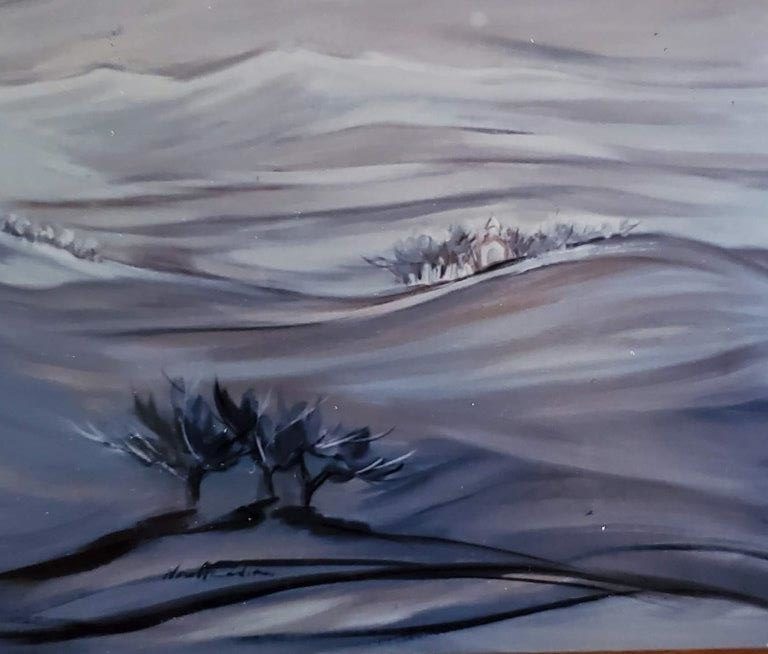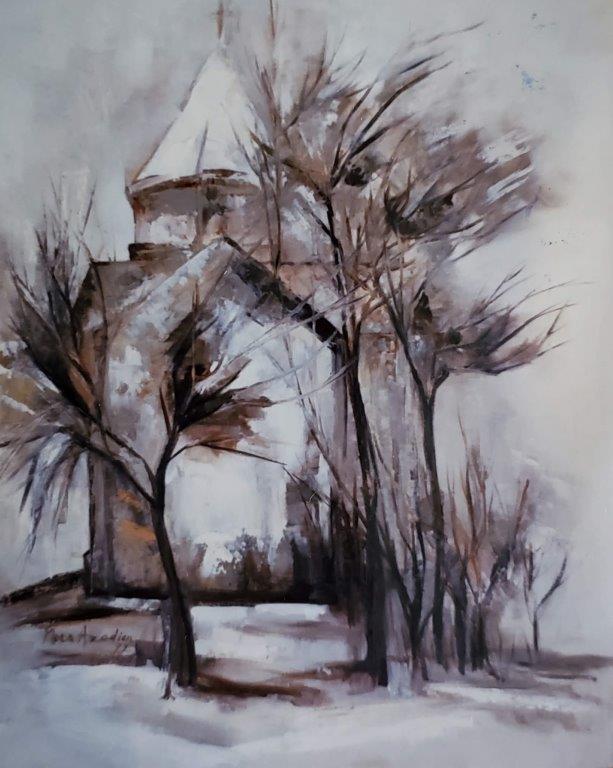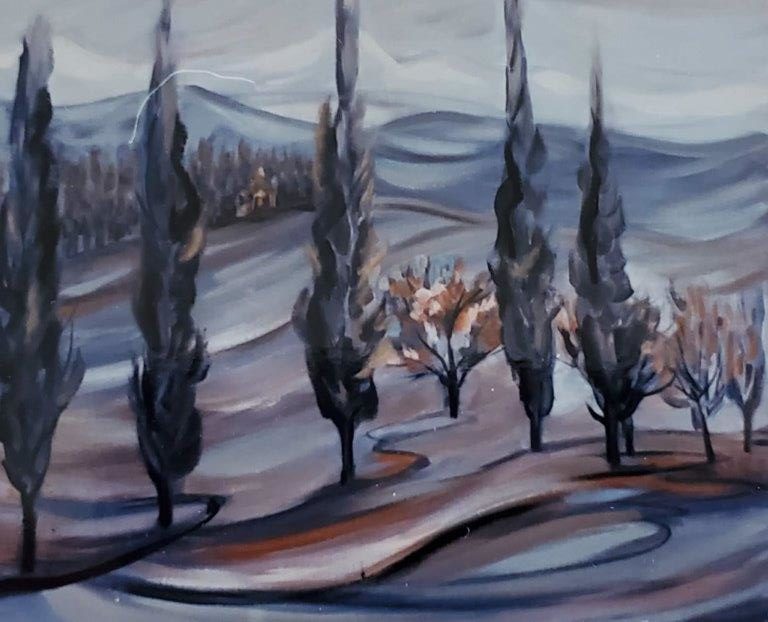The visit of Nora Azadian to the homeland was a revelation. She penetrated the reality of dream and spirit to become a great visionary artist.

The use of color became bolder; she rejected bright colors in favor of somber tones imparting a somber mood. Her brushwork became turbulent, more vigorous, which imbues atmosphere and enlivens the picture surface.
From Naturalistic Landscapes to Mystic Subjects
From naturalistic landscapes, Nora turned inwards to mystical subjects. Her imagination transformed Armenian history and culture, its churches and architectural remains into a wholly personal, original poetry.
With sensuously painted somber colors, permeated by unearthly light, Nora shaped nature’s essential forms and rhythms into a few superbly designed powerful masses.
Thematically related edifices, the churches, monasteries, castles, have a metaphoric significance; the link between the past and the present.

Eloquent in its simplicity of statement, the architectural monuments represent the entire history of a nation. A symbol of faith, a symbol of belief in survival, a symbol of triumph over destructive forces.
Nora took the colors of Armenia with all its splendors. Earth tones, browns, oranges, blues, in harmonious combinations are applied onto the canvas, ranging from subtle waves of color, to hold lines, with actively stroked pigment. An uninhibited use of color to define forms and express feeling with a coordination of pictorial tension throughout the surface of the canvas. Her moods range from poetic to enigmatic. With a characteristic spontaneity, mysticism and a complete disregard for “truth to nature.”
The colors of Armenia are also reflected in her “rhythm of momentum,” where undulating bands of color travel across the canvas, a simplification of peaks and valleys, and the rolling nature of the country painted in swiftly executed rhythmic movement.
Strong Colors – Simplification of Form
Strong colors, simplification of form with the elimination of detail recall the work of the Fauves, especially Maurice de Vlaminck, one of her idols, whose flat areas of color and vigorous brushstrokes are evident in some of her paintings.
Some of the work is not premeditated, but rather resembles a spontaneous outburst, a release of hidden energy painted rapidly with expressionistic vigor, recalling the brushstrokes of Franz Kline and the spatial arrangement of Pierre Soulages, where the gradation of her energetic brushstrokes also results in the impression of three dimensions.
These paintings carry the emotional impact of the abstract expressionists.
In her recent painting “The Fortress,” she goes even beyond the Fauves. There is a new violence and aggressiveness of attack, in the manner of de Kooning. The paint is vigorously applied onto the canvas in the heat of the execution and the loaded brush is allowed to drag and sweep across the canvas, trailing meteoric splashes and drips; characteristic means of execution of gestural abstractionism.
Her strong colors are softened with touches of white paint which create an interplay of light and shadow.
Nora’s paintings of Armenian landscapes and edifices indicate that she is not immune to the glory and romanticism of the Armenian legendary ruins.

The solemn architectural façade of a cathedral, isolated churches and monasteries, in silent rural suburban flatlands, on mountain tops and mountain slopes, represent vestiges of a past civilization, which served to fire the creative imagination of the artist.
As part of the composition, trees, much simplified in their outline and even distorted in their form, occupy a humanly void milieu, emphasizing a setting of desolate barrenness, and the meager remnants of past grandeur.
An unattainable church, perched on a mountain top, is symbolic. Appropriately titled “Elevation,” it represents the ambitions, the beliefs, and the aspirations of the people.
In “My Armenia,” Nora sought to create visual equivalents, not just for dreams or immediate perceptions, but also for a wide range of experiences including anguish, hope, alienation, suffering, passion and historical sentiments.
Her urban landscapes show her ability to perceive monumentality in the remnants of the churches and monasteries. She magnified the brushstrokes, the paintings became denser and the energies more explosive.
These historic edifices were unveiling the tragic past of her people.
This exhibition bears witness to the artist’s spiritual life and deep national convictions; it is a tribute to her skill, imagination and taste.
Around her monumental landscapes, bathing in Armenian colors, she creates an entire panorama of scenes which tell the story of an ancient civilization which left for posterity a rich legacy of historical and artistic achievements.
(Armenian Mirror-Spectator, 1980)
"artist" - Google News
May 29, 2021 at 03:24PM
https://ift.tt/2SCggw7
Nora Azadian – The Artist - The Armenian Mirror-Spectator
"artist" - Google News
https://ift.tt/2FwLdIu
Bagikan Berita Ini














0 Response to "Nora Azadian – The Artist - The Armenian Mirror-Spectator"
Post a Comment